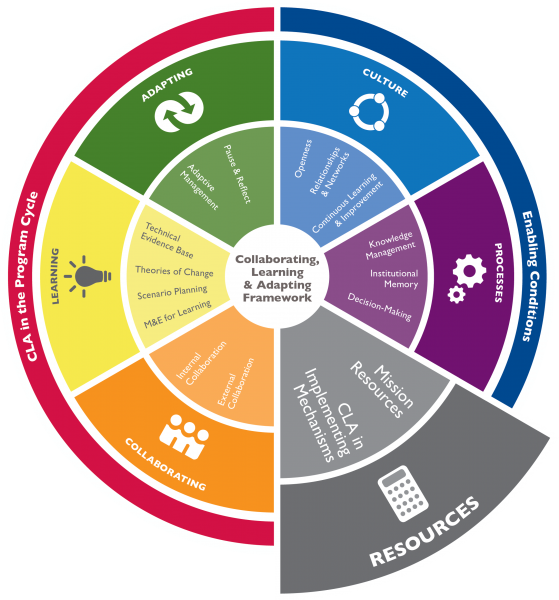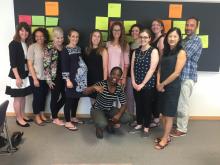Resourcing CLA: “Walking the CLA Talk” Part 3 of 6

This blog post is part of a USAID Learning Lab series called Working Smarter: Everyday CLA techniques to help you be more productive. The goal of the series is to share practical ways to integrate collaborating, learning, and adapting into your work.
Piers Bocock is Chief of Party of the USAID LEARN contract.
This January, we kicked off a 6-part blog series that reflects on the LEARN team’s efforts to “walk the [proverbial] talk” of the knowledge management and organizational learning through the lens of USAID’s Collaborating, Learning and Adapting (CLA) Framework. In the January post, we began our journey on the Enabling Conditions side of the framework, focusing on Culture. In February, I mused about Processes for effective enabling conditions for CLA. This month, we turn to Resources.
“walk the [proverbial] talk” of the knowledge management and organizational learning through the lens of USAID’s Collaborating, Learning and Adapting (CLA) Framework. In the January post, we began our journey on the Enabling Conditions side of the framework, focusing on Culture. In February, I mused about Processes for effective enabling conditions for CLA. This month, we turn to Resources.
How many of you have at one point o r another been designated the “learning lady” or the “KM guy,” and have had it just assumed you’ll wave your magic learning wand or build your silver bullet platform and everything will be great? I certainly have, on more than a few occasions. If so, then you know there are no magic wands, and no silver bullets when it comes to knowledge management and learning. It takes vision, leadership support, openness, trial and error, iteration, and above all, resources (a category under which I include people, funds, time, leadership support, and organizational culture).
r another been designated the “learning lady” or the “KM guy,” and have had it just assumed you’ll wave your magic learning wand or build your silver bullet platform and everything will be great? I certainly have, on more than a few occasions. If so, then you know there are no magic wands, and no silver bullets when it comes to knowledge management and learning. It takes vision, leadership support, openness, trial and error, iteration, and above all, resources (a category under which I include people, funds, time, leadership support, and organizational culture).
Knowledge management (KM) and organizational learning have started to gain traction in international development over the past 10-15 years. But from the beginning, there has been a false tension between assigning dedicated resources (i.e. KM “experts”) and finding ways to integrate these capacities into everyone’s jobs. In the early days of KM in development, Communities of Practice around KM and learning formed to connect like-minded individuals charged with “doing” KM. We used to joke that they served as support groups as much as anything else. KM4Dev and the Global Health Knowledge Collaborative are good examples, but there are others too, of course. As the development sector has increasingly come to appreciate the discipline, these groups have evolved and matured to focus more on sharing lessons, challenges, and innovations. As a result, we’ve seen a more holistic view of KM emerge, one that focus on supporting improved development impact through intentional learning and adaptive management. But that doesn’t mean that teams, projects, or organizations adequately resource KM and learning. Often, these are the last positions to be budgeted for, and the first to be cut. There’s still the assumption that because such capacity should be part of everyone’s job, dedicated resources are a luxury rather than a must.
When the initial USAID LEARN team met for the first time on January 5, 2015, the gathering felt surreal whereas I had fought my entire career to get more than one or two champions of organizational learning and KM, suddenly we had 10 of them on the same team. Dexis Consulting Group had assembled for USAID the most complete KM and learning team ever seen on one contract. It felt too good to be true, and yet here we were.
Even so, we have had to stay on guard that we don’t forget our own learning resources as we provide CLA support to USAID missions and bureaus. Because “resources” doesn’t just mean people. It means making time for strategic collaboration and sharing, and pausing and reflecting to understand what we are seeing and learning and when shifts in direction may be needed. It means budgeting funds for CLA activities, including staff time and platforms to capture, synthesize, and share knowledge and learning. And it means leadership prioritization. It’s one thing for leadership to give lip service to the importance for learning and adaptive management; it’s quite another for leadership to prioritize strategic direction such that time and space for learning are built into the day-to-day activities of their teams.
One of the great pleasures I get each year is co-teaching a course with my former colleague from (and now the current Project Director for) the Knowledge for Health project, Tara Sullivan. The course is through the Johns Hopkins Bloomberg School for Public Health, focusing on the role of KM and learning in improving public health programs. The fact that arguably the top medical school in the world recognizes the value of these disciplines is a powerful acknowledgement of the work that KM and learning champions do in international development; what is even more fun is the enthusiasm that students bring to the class.

Pictured above: Knowledge Management for Public Health in Low and Middle Income Countries Course 2016 Cohort
When we taught the course six years ago, the main concern from students was how to make the case for KM or even minimal inclusion of KM approaches in health programs. Over the past five years, the need has evolved from not whether to include KM and learning resources, but how much to resource. While the questions still arise around how much to budget or what good learning or KM “costs,” our experience in doing this work has led us to support our students, many of whom are professionals working in the KM and learning field, in identifying the “why, how, and what” of the programs they are supporting. This means truly understanding the overall purpose of the activity, project, or organization; figuring out how this purpose might be achieved; and then what specific actions, activities and resources will be required. Only then can one attempt to answer the question of “what does it cost?” But even that, I would suggest, is a trap worth avoiding, because ideally there is not a separate line item for KM and learning; ideally, these practices are integrated into all of one’s work. If I was hard pressed to categorize my time from a leadership perspective, I would estimate that fully 50% of my time is dedicated to strategic collaboration, continuous learning, and adaptive management. I spend at least another 25% on mentoring, management, and supervision; and then the remainder on actual technical work.
But while complete integration of KM and learning sounds great, I also want to be realistic. As with any good KM or learning plan, our goal is to make progress rather than strive for perfection. Here are some ways that my team tries to ensure we have adequate resources to our own internal work, as well when working with our clients:
Bring a KM and learning lens to the activity’s design from the outset. Make sure that someone with KM and learning capacity is part of the design and planning process. There are few things as frustrating as being pulled in at the end of an activity to “do knowledge management” on an effort that’s been going on for an extended period of time, without prior engagement. What previous/similar activities might we learn from as we design this new effort? What traps do we need to avoid? Who else is doing similar work?
Establish a plan for how we plan to monitor, learn from, and evaluate this effort. The goal is to develop a shared understanding of what we hope the activity is going to accomplish overall, and how strategic collaboration, continuous learning, and adaptive management might support that goal. Once identified, we need to agree on how we’re going to monitor progress, capture what we’re learning, and adapt if necessary. The days of doing monitoring and evaluation solely for accountability are gone; M&E for learning, in order to maximize impact, is the real value of M&E. So we need to know what constitutes success, and how will we know when we’ve achieved it (or if we’re off track and why).
Develop a Learning Agenda. What are the questions we hope to be able to answer as a result of this work, and how will we be able to answer them? For example, how are the interventions we selected contributing to our goal? Why or why not? How are these activities contributing to improved development results? If these questions are identified from the start of an activity, intentional learning has a much greater chance of being integrated into day-to-day work.
Try to avoid making KM and Learning be resourced as an “add-on.” And even when intentional collaborating, learning, and adapting approaches have not been included from the start, it’s still always possible to integrate them into existing processes; the key is not to make them new activities, but rather improvements to existing ones. Where we’ve seen success is when a team, project, or organization builds a KM and learning approach into what they’re already doing than as something new or distinct on top of everything else people are being asked to do. An effective learning approach applied to an existing activity is, in our experience, has a much greater chance of sustainability than creating an external, added-on “learning” or KM activity.
As I wrap up this post—and with it, the conclusion of my experience with the three main “enabling conditions” components of USAID’s CLA Framework (Culture, Processes, Resources) —allow me to reflect once more on the LEARN team and the results of effective and intentional CLA resources. It is our firm belief that without the enabling conditions for effective learning and knowledge management, learning and KM efforts will not be sustainable. In the January blog, we highlighted the value of an open, collaborative, and learning-based culture. In the February blog, we highlighted the importance of practical processes to support knowledge management, institutional memory, and decision-making. Likewise, without the appropriate time, leadership support, skills, culture and funding, it is hard to create conditions that support sustainable learning.
The final point I want to make is that the USAID LEARN contract is a great example of the Agency providing resources to back up a good idea. Collaborating, learning and adapting (CLA) is a concept that was “born” at USAID in 2009; in 2011 elements of it were written into the Program Cycle guidance; but USAID’s Bureau for Policy, Planning and Learning (PPL) needed to create a formal CLA Team as well as to fund a contract (USAID LEARN) to provide the resources to help make CLA a reality at USAID—something that is coming to fruition in new and unique ways every day (see USAID Learning Lab for examples of this), and is gradually being integrated into all USAID mission strategies. Without resourcing the CLA ideal, it’s hard to know whether a blog like this would even exist. And without walking the talk of CLA on our own team, I am positive we wouldn’t have the great, responsive, adaptable, creative, and learning focused team we have on LEARN.
As always, we appreciate your comments, feedback, and any shared experiences you may have related to this blog. Tune in next month when we turn our attention to “Collaboration.”



